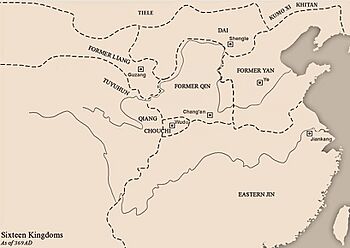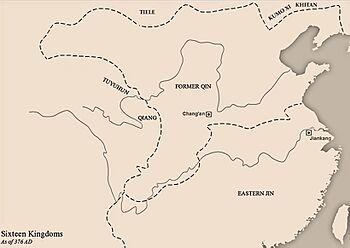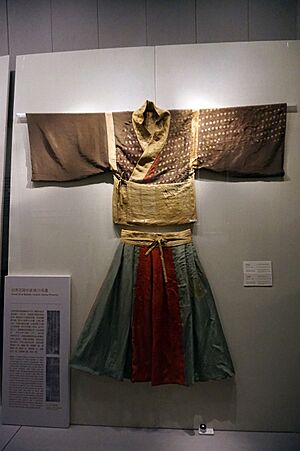Former Qin facts for kids
Quick facts for kids
Qin
秦
|
|||||||||||||||||||||||||||||||
|---|---|---|---|---|---|---|---|---|---|---|---|---|---|---|---|---|---|---|---|---|---|---|---|---|---|---|---|---|---|---|---|
| 351–394 | |||||||||||||||||||||||||||||||

Former Qin 369 CE
|
|||||||||||||||||||||||||||||||

Former Qin 376 CE
|
|||||||||||||||||||||||||||||||
| Capital | Chang'an (351–385) Jinyang (385–386) Nan'an (386–394) Huangzhong (394) |
||||||||||||||||||||||||||||||
| Government | Monarchy | ||||||||||||||||||||||||||||||
| Emperor | |||||||||||||||||||||||||||||||
|
• 351–355
|
Fu Jiàn | ||||||||||||||||||||||||||||||
|
• 355–357
|
Fu Sheng | ||||||||||||||||||||||||||||||
|
• 357–385
|
Fu Jiān | ||||||||||||||||||||||||||||||
| History | |||||||||||||||||||||||||||||||
|
• Fu Jiàn's entry into Chang'an
|
350 | ||||||||||||||||||||||||||||||
|
• Established
|
4 March 351 | ||||||||||||||||||||||||||||||
|
• Fu Jiàn's claim of imperial title
|
352 | ||||||||||||||||||||||||||||||
|
• Fu Jiān's destruction of Former Yan
|
370 | ||||||||||||||||||||||||||||||
| 383 | |||||||||||||||||||||||||||||||
|
• Fu Jiān's death
|
16 October 385 | ||||||||||||||||||||||||||||||
|
• Disestablished
|
394 | ||||||||||||||||||||||||||||||
|
• Fu Hong's death
|
405 | ||||||||||||||||||||||||||||||
|
|||||||||||||||||||||||||||||||
| Today part of | China | ||||||||||||||||||||||||||||||
| Former Qin | |||||||
|---|---|---|---|---|---|---|---|
| Chinese | 前秦 | ||||||
|
|||||||
The Former Qin (also called Fu Qin) was a kingdom in China that existed during the Sixteen Kingdoms period. It was ruled by the Fu family, who were part of the Di people. The Former Qin was founded in 351 after another kingdom, the Later Zhao, fell apart.
This kingdom became very powerful. In 376, under the rule of Fu Jiān, it managed to unite all of northern China. This was a big deal, as it was the only state during the Sixteen Kingdoms period to achieve such a feat. Its capital city was Chang'an until Fu Jiān's death in 385. The word "Former" is used to tell it apart from the "Later Qin" kingdom, which came after it.
However, in 383, the Former Qin suffered a huge defeat against the Jin dynasty at the Battle of Fei River. This loss weakened the kingdom and led to many uprisings. After Fu Jiān died, the Former Qin split into smaller pieces. One part in present-day Taiyuan was soon taken over by other groups. Another part struggled in smaller areas around Shaanxi and Gansu until it finally collapsed in 394.
Most rulers of Former Qin called themselves "Emperor." However, Fu Jiān chose the title "Heavenly King." Even so, after his death, the Former Qin court still considered him an emperor.
Contents
History of the Former Qin
Early Beginnings
The Fu family was originally known as Pu. They were an important tribe in the Lüeyang area. When other parts of China faced trouble, many people came to them for safety. Their leader, Pu Hong, declared his independence. Later, he joined the Former Zhao kingdom, which was led by the Xiongnu people.
After a new kingdom, the Later Zhao, took over, Pu Hong moved his people closer to the capital. He became a trusted general. When the Later Zhao kingdom started to fall apart, Pu Hong saw his chance. He led his armies west, planning to create his own independent state. He changed his family name to Fu, as a prophecy suggested. He then called himself the King of the Three Qins. Sadly, he was killed by one of his own generals before he could fully establish his kingdom.
The First Rulers
Pu Hong's son, Fu Jiàn, quickly stopped the rebellion and took over. At first, he said he was still loyal to the Jin dynasty. But after he captured the important city of Chang'an, he declared his independence. He took the title of Heavenly King of Qin.
In 352, Fu Jiàn became the Emperor of Qin. He expanded his kingdom by defeating other groups. He also fought against the Former Liang kingdom for control of the Longxi region. His biggest challenge came in 354. The Eastern Jin dynasty attacked, but Fu Jiàn managed to push them back. During this fight, his son, Fu Chang, was killed.
Fu Jiàn died in 355, and his son, Fu Sheng, became emperor. Some historians say Fu Sheng was a very harsh ruler. He killed many important officials for small reasons. He forced the Former Liang kingdom to surrender. But when he planned to kill his cousins, he was overthrown in 357. His cousin, Fu Jiān (a different person with a similar name), led the takeover.
Fu Jiān's Rise to Power
When Fu Jiān became ruler, he changed his title back to Heavenly King. Even though he was from the Di people, he had a strong education in Confucianism. This was a system of beliefs that focused on good behavior and order. He hired many Han Chinese officials, especially his Prime Minister, Wang Meng.
With Wang Meng's help, Fu Jiān made many improvements.
- He focused on farming to make the state stronger.
- He built irrigation systems to help crops grow.
- He moved different groups like the Xiongnu and Xianbei people to work on farms.
- He made the government more organized and stopped corruption.
- He also made education very important and brought back old Chinese traditions.
Early in his rule, Fu Jiān faced some internal rebellions. But by 368, he had mostly solved these problems. His main rivals were the Former Yan kingdom to the east and the Eastern Jin to the south.
Uniting Northern China
In 369, Fu Jiān's forces, led by Wang Meng, attacked the Former Yan. By the end of 370, they had conquered all of Yan. Former Qin continued to expand. In 371, they conquered Chouchi, and in 373, they took Sichuan from Jin.
The Former Qin completed its unification of northern China in 376. They conquered the Former Liang and Dai kingdoms. Fu Jiān was kind to his defeated enemies. He even allowed them to work in his government.
The Former Qin also started to receive visitors from other countries, like Silla and Goguryeo. Fu Jiān was interested in Buddhism as well as Confucianism. In 379, he welcomed a Buddhist monk named Dao'an to his court. He even sent a general, Lü Guang, on a trip to the Western Regions in 382. He asked Lü Guang to bring back a famous monk named Kumārajīva from Kucha.
The Battle of Fei River
The Eastern Jin kingdom was the last major state standing in the way of Former Qin uniting all of China. Wang Meng, Fu Jiān's trusted advisor, died in 375. Before he died, he warned Fu Jiān not to attack Jin. He advised him to focus on making his own kingdom stronger. Many of the people Fu Jiān had conquered, like the Qiang and Xianbei, were not fully loyal.
However, Fu Jiān did not listen. To try and make the conquered people more loyal, he moved many Qiang and Xianbei people closer to his capital. He hoped this would help different ethnic groups live together.
In 378, Former Qin forces attacked Xiangyang and Pengcheng. Xiangyang fell to Qin in 379, but the attack on Pengcheng was stopped by the Jin general, Xie Xuan. In 383, Fu Jiān decided to invade Jin. He wanted to unite all of China. Most of his advisors were against it, but he went ahead with a huge army, said to be 1 million strong.
The Former Qin army captured Shouchun. Then they faced the Jin army, led by Xie An, at the Battle of Fei River. During the battle, a Former Qin general named Zhu Xu, who used to be with Jin, betrayed Fu Jiān. He shouted, "The Qin army is defeated!" This caused huge panic among the Qin soldiers. They fled in confusion, and the Jin army chased them. The Former Qin suffered a terrible defeat. Fu Jiān himself was hurt and barely escaped.
The Fall of Former Qin
After the defeat at Fei River in 384, the Former Qin kingdom was in trouble. A Xianbei general named Murong Chui, who was a prince from the Former Yan kingdom, rebelled. He started the Later Yan dynasty, wanting to bring back his family's old kingdom. His nephew, Murong Hong, also rebelled near Chang'an, starting the Western Yan.
Fu Jiān tried to stop these uprisings. But then, his Qiang general, Yao Chang, also rebelled. Yao Chang started the Later Qin dynasty. Fu Jiān was trapped in Chang'an by the Western Yan forces. He had to leave the city because there wasn't enough food. In 385, he was captured by Yao Chang. Fu Jiān refused to give up his throne, so Yao Chang had him killed.
More rebellions broke out across the empire.
- In 385, the Qifu-Xianbei tribe formed the Western Qin dynasty.
- The Chouchi state was also restored.
- In 386, Lü Guang, who had been on his trip to the Western Regions, took over Liang province. He founded the Later Liang.
- The Tuoba-Xianbei people brought back their state of Dai, which later became the Northern Wei dynasty.
- Meanwhile, the Eastern Jin forces, led by Xie Xuan, took back much of their lost land.
Fu Jiān's son, Fu Pi, declared himself emperor in 385. He tried to bring back the Former Qin's power from Jinyang. But he was badly defeated by the Western Yan. His short rule ended in 386 when he was killed by Jin forces.
A distant cousin of Fu Jiān, Fu Deng, became the new emperor in Nan'an. He fought against the Later Qin kingdom. He had some success at first, but then suffered a big defeat at the Battle of Dajie in 389. After that, he couldn't launch any more major attacks. In 394, he tried one last attack on Later Qin. His main army was destroyed, and he was captured and killed by Yao Xing, Yao Chang's successor.
Fu Deng's son, Fu Chong, fled to Huangzhong and declared himself emperor. But soon after, the Western Qin forces took over his remaining land. Fu Chong was killed in battle, which marked the official end of the Former Qin dynasty.
After the Former Qin fell, members of the Fu family spread out across China. Some joined other kingdoms, like the Eastern Jin or the Later Yan.
Rulers of the Former Qin
| Temple name | Posthumous name | Personal name | Durations of reigns | Era names |
|---|---|---|---|---|
| Gaozu | Jingming | Fu Jian (苻健) | 351–355 | Huangshi (皇始) 351–355 |
| – | King Li¹ | Fu Sheng | 355–357 | Shouguang (壽光) 355–357 |
| Shizu | Xuanzhao | Fu Jian (苻堅) | 357–385 | Yongxing (永興) 357–359 Ganlu (甘露) 359–364 |
| – | Aiping | Fu Pi | 385–386 | Taian (太安) 385–386 |
| Taizong | Gao | Fu Deng | 386–394 | Taichu (太初) 386–394 |
| – | – | Fu Chong | several months in 394 | Yanchu (延初) 394 |
¹ Fu Sheng was given the title "wang" (meaning king) after his death, even though he had ruled as emperor.
Rulers family tree
| Former Qin | |||||||||||||||||||||||||||||||||||||||||||||||||||||||||||||||||||||||||||||||||||||||||||||||||||||||||||||||||||||||||||||||||||||||||||||||||||||||||||||||||||||||||||||||||||||||||||||||||||||||
|---|---|---|---|---|---|---|---|---|---|---|---|---|---|---|---|---|---|---|---|---|---|---|---|---|---|---|---|---|---|---|---|---|---|---|---|---|---|---|---|---|---|---|---|---|---|---|---|---|---|---|---|---|---|---|---|---|---|---|---|---|---|---|---|---|---|---|---|---|---|---|---|---|---|---|---|---|---|---|---|---|---|---|---|---|---|---|---|---|---|---|---|---|---|---|---|---|---|---|---|---|---|---|---|---|---|---|---|---|---|---|---|---|---|---|---|---|---|---|---|---|---|---|---|---|---|---|---|---|---|---|---|---|---|---|---|---|---|---|---|---|---|---|---|---|---|---|---|---|---|---|---|---|---|---|---|---|---|---|---|---|---|---|---|---|---|---|---|---|---|---|---|---|---|---|---|---|---|---|---|---|---|---|---|---|---|---|---|---|---|---|---|---|---|---|---|---|---|---|---|
|
|||||||||||||||||||||||||||||||||||||||||||||||||||||||||||||||||||||||||||||||||||||||||||||||||||||||||||||||||||||||||||||||||||||||||||||||||||||||||||||||||||||||||||||||||||||||||||||||||||||||
See also
- Battle of Fei River
- Di (Five Barbarians)
- Five Barbarians
- Su Hui (poet)
- Wang Meng


